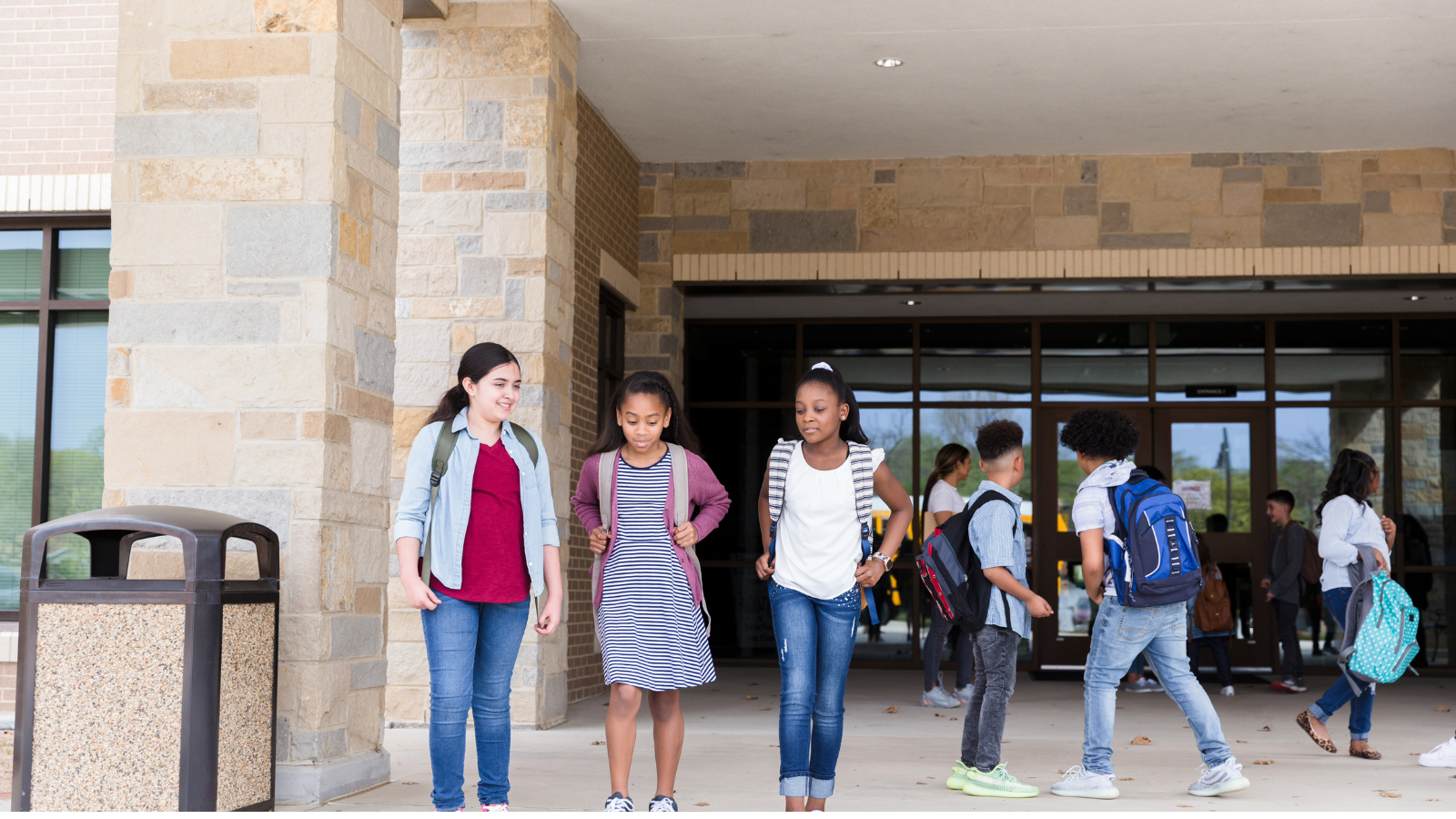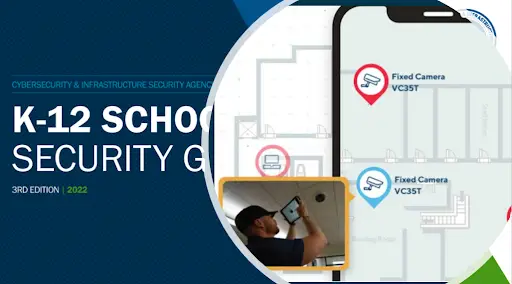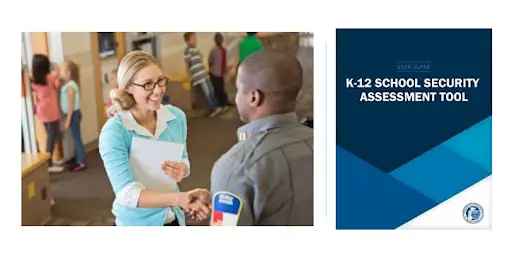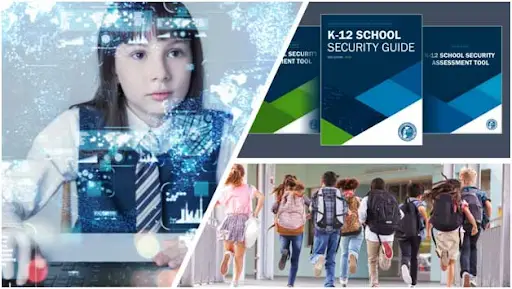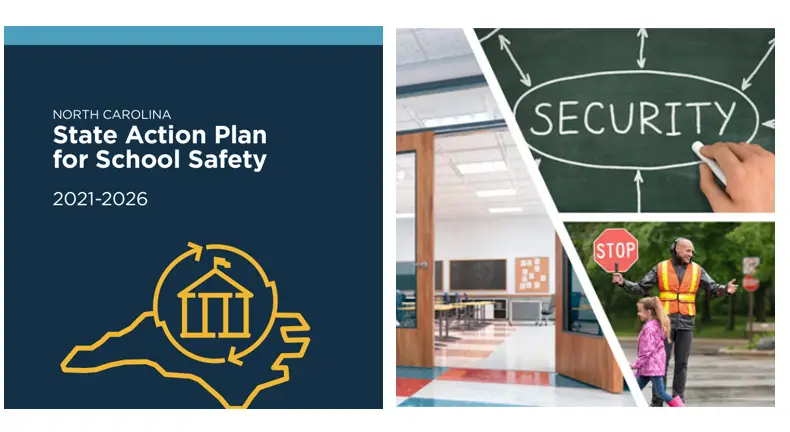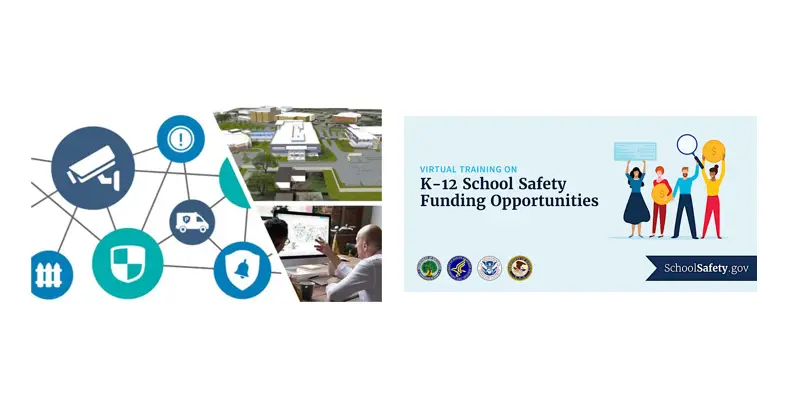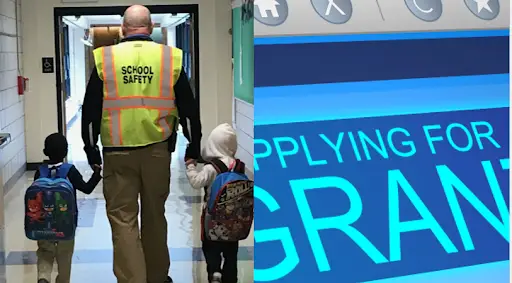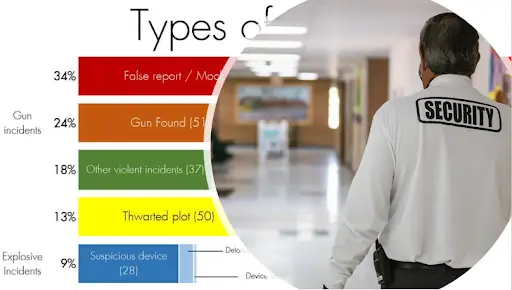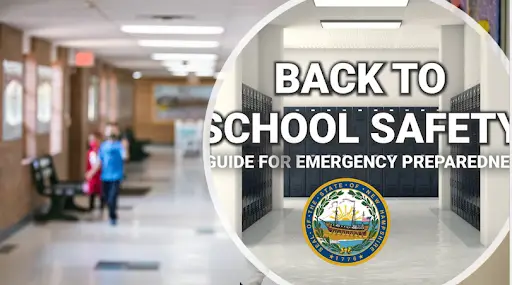School safety remains a critical focus for K-12 leaders. Daily operations, such as managing student dismissal and preparing for emergencies, present multifaceted challenges that require a comprehensive and layered approach.
As threats from school violence, unauthorized access, and broader community safety concerns evolve, a multidisciplinary, systems-based strategy for physical security has become essential.
A systems-based approach integrates risk assessment, layered defenses, and coordinated policies with technology. By strategically combining people, policy, and technology, schools can cultivate secure environments where education and growth can flourish.
To support these efforts, we’ve compiled 24 essential K-12 school security resources updated for 2025 to help school administrators adopt a proactive, practical approach to security.
Table of Contents
- CISA K-12 school security [Guide]
- K-12 school security assessment [Tool]
- School safety communications planning [Guide]
- K-12 systems approach to physical security [Report]
- Creating a campus security plan [Article]
- State action plan for school safety [Guide]
- School safety grant finder [Tool]
- Elementary and secondary school emergency (Relief Fund)
- Support America’s families and educators (Grant)
- Project school emergency response to violence (Grant)
- Office of formula grants [Resource Center]
- Implementing physical security measures in schools [Report]
- Conducting school safety and security audits [Toolkit]
- Best practices for school security [Article]
- Analysis of targeted school violence [Case Study]
- Homeland security K-12 school security [Guide]
- Campus resilience program [Starter Kit]
- K-12 emergency management virtual [ToolKit]
- Safety readiness resource assessment [Tool]
- Best security practices for school administrators [PDF]
- Comprehensive school security framework [Guide]
- Physical security measures overview [Guide]
- How US schools are updating their security plans [Article]
- School security system management [Platform]
Article FAQs
Q1: Who is this guide for?
This guide is for K-12 administrators, security directors, and facility managers looking for practical tools to improve school safety and emergency readiness.
Q2: What’s new in the 2025 update?
We’ve updated the list with the latest tools, grants, and best practices to address today’s evolving security threats and funding opportunities.
Q3: Are these resources free?
Most resources are free or grant-funded, with direct access or application links provided where available.
Q4: How can these resources be used effectively?
They support audits, policy updates, system upgrades, emergency planning, and help with securing funding.
Q5: Where should I start?
Begin with the CISA K-12 Guide and Security Assessment Tool to identify gaps and build a strong foundation.
Q6: Can these resources help with grant applications?
Yes! Several tools, such as the Grant Finder and ESSER Fund guidance, are designed to help districts identify and apply for funding.
Q7: What is SiteOwl, and how can schools use it?
SiteOwl is a cloud-based platform that helps schools manage security systems like cameras and access control. It streamlines maintenance, boosts visibility, and supports safer, more efficient security planning.
1. CISA K-12 school security [Guide]
The CISA K-12 School Security Guide is a cornerstone resource for school safety planning. Published by the Cybersecurity and Infrastructure Security Agency (CISA), it delivers a step-by-step framework that helps districts strengthen their security posture without overwhelming staff or budgets.
For school administrators, the guide provides practical, scalable strategies that can be tailored to schools of all sizes. Whether it’s developing stronger access control procedures, coordinating with local law enforcement, or creating layered defense plans, the guide helps leaders move from broad policy goals to actionable improvements on the ground.
Instead of leaving schools to piece together fragmented safety measures, CISA offers a comprehensive playbook that administrators can adapt to their unique challenges, whether it’s securing entry points, preparing for active threats, or enhancing communication protocols.
Inside the guide school security leaders will find:
- A layered approach to school security, covering revention, protection, mitigation, and recovery.
- Practical strategies for conducting vulnerability assessments across campuses.
- Guidance for prioritizing upgrades so schools focus on measures that deliver the most impact.
Download: CISA’s K-12 school security guide
2. K-12 school security assessment [Tool]
The K-12 School Security Assessment Tool (SSAT) is a free resource from CISA designed to help schools take stock of their current safety and security measures. By guiding administrators through a structured self-assessment, the tool highlights strengths, identifies gaps, and provides a roadmap for continuous improvement.
For school leaders, the SSAT is especially useful for building an objective baseline of existing measures. It covers areas such as access control, emergency communications, facility design, and staff preparedness, giving districts a clear picture of where resources are effective and where adjustments are needed.
What the SSAT helps schools accomplish:
- Inventory current security measures across campuses.
- Identify gaps and vulnerabilities in policies, procedures, and technology.
- Focus on both protection (preventing threats and emergencies) and mitigation (reducing harm when incidents occur).
- Provide a foundation for data-driven security planning and grant applications.
Access: CISA K-12 school security assessment
Without a clear baseline, schools risk investing in solutions that don’t address their most pressing vulnerabilities. The SSAT ensures leaders make smarter, targeted decisions when updating safety plans or requesting funding.
3. School safety communications planning [Guide]
The School Safety Communications Planning Guide gives administrators a practical framework for building clear, effective communication strategies around school safety. Designed as a quick-start resource, it helps districts ensure that critical information is delivered to the right people—students, staff, parents, and the broader community—before, during, and after a security event.
For school leaders, this guide emphasizes the value of transparent and proactive communication. Whether announcing new safety initiatives, coordinating with first responders, or addressing parents during an emergency, having a clear plan reduces confusion and builds trust.
Inside the guide, you’ll find:
- Templates for sharing safety-related updates with staff and families.
- Guidance on designating spokespersons and clarifying roles.
- Best practices for multi-channel communication, including digital alerts, phone trees, and community briefings.
- Strategies to strengthen trust and transparency between schools and their communities.
In a crisis, communication failures can quickly escalate confusion and risk. This guide ensures districts have a clear, repeatable framework for keeping stakeholders informed and reassured.
Review: School safety communications planning guide
4. K-12 systems approach to physical security report
The K-12 Systems Approach to Physical Security Report consolidates insights from a wide range of disciplines, including education, law enforcement, architecture, and emergency management, to present a comprehensive, systems-based strategy for school security. Instead of treating safety as a series of isolated fixes, the report emphasizes integration across people, policies, and technology.
For district leaders, this report provides a research-backed foundation for designing security programs that are both effective and sustainable. It bridges the gap between academic theory and real-world application, showing how schools can create safer environments without undermining the educational mission.
Key takeaways from the report include:
- Why a systems-based approach is more effective than one-off security measures.
- How to align physical infrastructure (locks, cameras, access control) with policy..
- Case studies illustrating how layered security works across diverse school settings.
- Recommendations for coordinating with local law enforcement and emergency responders.
Security in schools is never just about hardware. This report demonstrates how a holistic, interdisciplinary approach reduces risks while maintaining a supportive learning environment.
Review the K-12 systems approach to physical security report
5. Creating a campus security plan [Article]
Published by the Partner Alliance for Safer Schools (PASS), this article outlines a four-step framework for developing a campus security plan that aligns with both safety needs and educational priorities. PASS is a widely respected authority in school security standards, making this a practical, trusted guide for districts seeking structured improvement.
For school administrators, the process offers a clear roadmap for moving from big-picture goals to actionable security measures. By following the framework, leaders can ensure that campus security planning is comprehensive, consistent, and scalable across multiple facilities.
The four key steps include:
- Designing a plan tailored to the school’s unique risks and resources.
- Establishing measurable goals to track progress and accountability.
- Conducting a risk assessment to identify vulnerabilities across people, policies, and infrastructure.
- Building infrastructure capacity to support sustainable safety improvements.
Review: Creating a campus security master plan
6. State action plan for school safety [Guide]
While federal guidelines set national standards, schools must also align with state-level mandates and community priorities. The North Carolina State Action Plan for School Safety (SAPS), developed by the Task Force for Safer Schools, is a strong example of how states can create coordinated, long-term strategies. This five-year plan provides a framework that districts across the country can adapt as a model for collaboration between education agencies, state government, and local communities.
For administrators, SAPS demonstrates how to translate broad safety goals into state-supported initiatives that account for regional laws, resources, and cultural context. It also highlights the importance of multi-agency coordination, ensuring that schools, law enforcement, health services, and community leaders work together toward shared outcomes.
Key features of SAPS include:
- A five-year strategic roadmap for continuous improvement in school safety.
- Guidance for districts to align local initiatives with state-level priorities.
- A framework for multi-agency coordination between schools, law enforcement, and community partners.
Federal resources are invaluable, but school safety is ultimately local. A state-driven plan like SAPS helps districts build sustainable, community-focused security programs that align with both policy and practice.
Review the North Carolina state action plan for school safety
7. School safety grant finder [Tool]
The School Safety Grant Finder Tool, hosted on SchoolSafety.gov, is a centralized hub for discovering federal funding opportunities dedicated to school safety. Instead of searching across multiple agencies, administrators can use this tool to quickly identify grants that fit their district’s needs and capacity.
For school leaders, the Grant Finder Tool is especially valuable because it allows users to filter opportunities by safety topic, award amount, eligibility, and application effort. This makes it easier to target funding programs that are both relevant and realistically achievable given staff bandwidth.
Key features include:
- Access to a comprehensive database of federal grants for K-12 school safety.
- Filters for topics, award amounts, and application requirements.
- Direct links to grant applications and program details.
Funding is one of the biggest barriers to implementing new security measures. The Grant Finder Tool simplifies the process, ensuring districts don’t miss critical opportunities to secure financial support for safety initiatives.
Access: School safety grant finder tool
8. Elementary and secondary school emergency (Relief Fund)
The Elementary and Secondary School Emergency Relief (ESSER) Fund, established under the American Rescue Plan (ARP), provides billions in federal aid to help schools address urgent needs, including safety and security. Since its launch in 2021, ESSER funding has enabled districts to invest in both pandemic response measures and long-term improvements to the learning environment.
For school leaders, ESSER is a flexible funding source that can support physical security initiatives such as facility upgrades, emergency preparedness, and technology improvements, alongside broader educational needs. With $6.3 billion allocated to local education agencies (LEAs), this program remains one of the largest opportunities for schools to secure meaningful funding.
Key features of ESSER include:
- Funding allocations distributed directly to LEAs based on federal formulas.
- Support for health, safety, and physical security measures.
- Flexibility to apply funds toward infrastructure, technology, and resilience planning.
While designed for pandemic relief, ESSER has also become a vital resource for schools modernizing their facilities and strengthening security. Districts that strategically align safety upgrades with ESSER funding requirements can maximize their impact while staying compliant.
Apply to the: Elementary and secondary school emergency relief
9. Support America’s families and educators (Grant)
The Support America’s Families and Educators (SAFE) Grant was created to ensure that school districts are not penalized for following public health and safety guidelines. Specifically, it provides funding to districts that have had funds withheld—or faced other financial penalties, for implementing CDC-aligned safety measures, such as universal indoor masking and other preventive strategies.
For administrators, the SAFE Grant is an important backstop that helps districts maintain critical funding while prioritizing student and staff well-being. Beyond pandemic-related safety, these funds can also support broader school safety initiatives when aligned with federal guidelines.
Key features of the SAFE Grant include:
- Financial relief for schools penalized for following CDC-recommended safety measures.
- Additional support for districts affected by withheld state funding.
- Alignment with broader federal emergency relief programs, including ESSER.
Political and policy differences shouldn’t prevent schools from protecting their students. The SAFE Grant helps ensure districts can continue implementing safety measures—without losing critical funding in the process.
Apply to the: Elementary and secondary school emergency relief
10. Project school emergency response to violence (Grant)
The Project School Emergency Response to Violence (Project SERV) Grant provides short-term education-related services to schools and higher education institutions recovering from a violent or traumatic event. Funded through the U.S. Department of Education, this grant helps restore a safe learning environment when an incident has disrupted normal operations.
For administrators, Project SERV offers immediate financial support to cover costs such as mental health services, substitute staff, temporary security measures, and crisis response coordination. While the funding is short-term, it plays a critical role in stabilizing schools during recovery and laying the groundwork for long-term resilience.
Key features of Project SERV include:
- Funding to help schools recover afte violent or traumatic incidents.
- Support for counseling, mental health, and crisis response services.
- Coverage for temporary security personnel and resources.
Violence and trauma can have lasting impacts on both students and staff. Project SERV ensures that schools have the resources to address immediate safety and emotional needs, helping communities recover and return to learning as quickly as possible.
Apply to the: Project school emergency response to violence
11. Office of formula grants [Resource Center]
The Office of Formula Grants, under the U.S. Department of Education’s Office of Elementary and Secondary Education (OESE), manages a wide range of funding programs that directly impact K-12 schools. This resource center provides school leaders with the tools, policies, and strategies they need to navigate formula-based grants effectively.
For administrators, the center serves as a guide to understanding how formula grants are allocated and administered, ensuring that districts receive the funding they are entitled to and apply it in compliance with federal guidelines. It also offers insights into improving grant management practices, which can make a significant difference when balancing limited budgets against growing safety needs.
Key features of the Resource Center include:
Oversight of major formula grant programs that support K-12 education and safety. Guidance on policy implementation and compliance requirements. Tools for improving the efficiency of grant administration at the district level.
Formula grants make up a large portion of federal education funding. By using this resource center, districts can ensure they are maximizing available funds to support security initiatives alongside academic needs.
Resources for implementing K-12 physical security measures
12. Implementing physical security measures in schools [Report]
The Implementing Physical Security Measures in Schools Report was authored by leading school security professionals and addresses the practical challenges districts face when putting safety policies into action. While many policies and recommendations exist across agencies, they are often scattered, inconsistent, or difficult to interpret—leaving local education agency (LEA) leaders without a clear path forward.
This report helps bridge that gap by consolidating guidance into a comprehensive resource. It highlights common barriers schools encounter—such as funding limitations, policy conflicts, and limited technical expertise—and provides actionable strategies for overcoming them.
Key insights from the report include:
- How to navigate fragmented federal and state guidance on school safety.
- Practical recommendations for implementing policies at the district level.
- Considerations for balancing compliance requirements with local needs.
Having a security plan is one thing, executing it effectively is another. This report gives administrators the clarity and direction they need to move from policy to practice, ensuring security measures are not only adopted but also effective in protecting students and staff.
Review the challenges in implementing physical security measures in K-12 schools
13. Conducting school safety and security audits [Toolkit]
The School Safety and Security Audits Toolkit provides administrators with a structured approach to evaluating safety measures across their campuses. Developed as a hands-on resource, the toolkit helps districts move beyond theory by conducting real-world audits that identify vulnerabilities and highlight areas for improvement.
At the heart of the toolkit are two detailed checklists:
- The Comprehensive Document Review Checklist, which guides administrators in reviewing policies, emergency plans, and records.
- The School Facility Audit Checklist, which focuses on on-site procedures, physical conditions, and operational practices within schools and support facilities.
By combining both policy and facility-level assessments, the toolkit ensures schools gain a 360-degree view of their security posture, from written protocols to how systems and staff operate day to day.
Access the school safety and security audits toolkit
14. Best practices for school security [Article]
The Best Practices for School Security article emphasizes the importance of a systems-based approach, where policies, procedures, and physical measures work together across every layer of protection. Rather than relying on a single solution, this resource encourages administrators to adopt a layered defense strategy that addresses prevention, preparedness, response, and recovery.
The article offers actionable recommendations that schools can adapt to their unique environments, such as strengthening access control procedures, updating emergency drills, and ensuring technology investments align with long-term safety goals. It also points leaders to additional resources for building a robust, sustainable security posture.
Highlights from the article include:
- Guidance on creating layered physical security strategies.
- Tips for aligning daily operations with emergency readiness.
- Recommendations for integrating policy, people, and technology.
No two schools are alike, but every school can benefit from adopting structured best practices. This article helps administrators ensure that their security programs are comprehensive, consistent, and adaptable to evolving threats.
Read: K-12 best practices for a strong security posture – security operations.
15. Analysis of targeted school violence [Case Study]
The Analysis of Targeted School Violence Case Study, developed by federal researchers, examines real-world incidents to uncover patterns and provide actionable strategies for prevention. It underscores the importance of establishing a multidisciplinary threat assessment team to identify risks before they escalate.
For school leaders, the case study demonstrates that prevention is possible when the right policies, tools, and training are in place. By reviewing key findings, districts can better understand the warning behaviors, intervention opportunities, and systemic gaps that often precede acts of school violence.
Key insights from the case study include:
- The role of multidisciplinary teams in identifying and mitigating threats.
- Common warning signs and behaviors observed before violent incidents.
- The importance of policies and training that empower staff to act proactively.
Every incident leaves behind lessons that can guide stronger safety practices. This case study turns tragedy into knowledge, giving administrators the tools to recognize risks early and respond effectively.
Review: Analysis of targeted school violence case study
16. Homeland security K-12 school security [Guide]
The Homeland Security K-12 School Security Guide focuses on one of the most urgent threats facing schools today: gun violence and active shooter incidents. Developed by the Department of Homeland Security (DHS), the guide provides preventive and protective strategies designed specifically for K-12 environments.
For administrators, this resource delivers clear, actionable steps for reducing risks and strengthening preparedness. It addresses both physical measures, such as secure entryways, lockdown protocols, and surveillance, and procedural approaches, including training staff, coordinating with law enforcement, and communicating effectively with parents and students during a crisis.
Key elements of the guide include:
- Preventive strategies to reduce the likelihood of violence.
- Protective measures to mitigate impact during active shooter events.
- Recommendations for school-law enforcement coordination.
While no single measure can eliminate the risk of school violence, this guide provides schools with a structured, DHS-backed framework to prepare for and respond to one of the most serious security challenges facing education today.
Access: Homeland security K-12 school security guide
17. Campus resilience program [Starter Kit]
The Campus Resilience Program Starter Kit equips schools with self-conducted tabletop exercises (TTX) designed specifically for the academic community. Each kit provides a set of scalable tools that allow schools to test their existing emergency plans, protocols, and procedures in a low-risk environment.
For administrators, the kit offers a practical way to evaluate preparedness without waiting for a real-world crisis. By walking staff through simulated emergency scenarios, districts can identify strengths, uncover gaps, and strengthen their capacity to respond and recover effectively.
Key features of the Starter Kit include:
Ready-to-use tabletop exercise scenarios for schools and districts.
Tools to evaluate current emergency plans under realistic conditions. Scalable design adaptable for individual schools or district-wide use.
Plans only work if they’re tested. This starter kit gives schools a structured, repeatable method to evaluate and refine their emergency readiness before real-world events put them to the test.
Access: Campus resilience program [Starter Kit]
18. K-12 Emergency management virtual [ToolKit]
The K-12 Emergency Management Virtual Toolkit, developed by the Readiness and Emergency Management for Schools (REMS) Technical Assistance Center, is an online hub designed to help education agencies provide consistent and comprehensive resources to the schools they serve.
Through this web-based platform, districts can easily share guidance, training modules, and practical tools that support schools in developing, updating, and standardizing their emergency management programs.
By streamlining access to resources, the toolkit helps ensure that all schools under a district’s umbrella receive uniform information and best practices.
Key features of the Virtual Toolkit include:
A centralized platform for sharing resources across K-12 schools.Practical guidance and training modules aligned with federal best practices.Tools that support consistent emergency planning and response protocols.
Easy customization for district-wide or regional implementation.
When every school in a district works from the same playbook, emergency management becomes more effective. This toolkit empowers education agencies to standardize planning, training, and response efforts across all their schools.
Access: Emergency management virtual toolkit
19. Safety readiness resource assessment [Tool]
The Safety Readiness Resource Assessment Tool is designed to help schools evaluate their unique safety needs and identify practical steps for improvement. Because every school environment is different, this tool offers actionable recommendations and considerations that schools can adapt to strengthen their emergency preparedness and overall safety posture.
By using the assessment, administrators and safety teams can:
- Pinpoint gaps and vulnerabilities in existing safety measures.
- Access a structured list of common actions proven effective across schools.
- Develop or refine plans that reflect their specific environment and risks.
- Build a more comprehensive, tailored approach to creating safe learning environments.
School safety planning can feel overwhelming without clear direction. This tool provides a starting point and roadmap for schools to align their safety efforts with best practices while addressing local needs.
Access: Safety readiness resource assessment tool
20. Best security practices for school administrators [PDF]
Safe Schools for Alex provides a comprehensive guide highlighting the most current school safety best practices for administrators. This resource is designed to support school leaders, parents, districts, and law enforcement in working together to ensure that all children have a safe learning environment.
The PDF guide covers:
- Proven strategies for enhancing school safety and security.
- Collaboration models between schools, families, and law enforcement.
- Actionable guidance tailored to the unique role of administrators.
Administrators are at the forefront of policy, planning, and decision-making for school safety. This guide equips them with practical insights and proven frameworks to foster secure, supportive learning environments.
Review: Best security practices for school administrators
21. Comprehensive school security framework [Guide]
The Comprehensive School Security Framework is a collaborative initiative designed to give schools and stakeholders a complete set of policies, practices, and procedures for building safe learning environments. This guide serves as a roadmap for schools and communities to align their safety efforts with national best practices.
The framework helps schools and districts:
- Prevent and mitigate risks through proactive planning.
- Prepare and respond effectively to potential threats or violence.
- Recover and restore safe, supportive learning conditions after an incident.
School safety requires a whole-community approach. This guide empowers educators, administrators, and local partners to work together in creating layered, sustainable safety strategies tailored to their unique environment.
Review: Comprehensive school security framework guide
22. Physical security measures overview [Guide]
Designed for school personnel, this resource provides a snapshot of what physical security measures are and how they can be implemented in a school. It breaks down essential strategies that strengthen a school’s protection against threats while supporting a safe learning environment.
Key areas covered include:
- Access control strategies to manage entry and exit points.
- Surveillance tools for monitoring activity in and around campus.
- Barriers and protective design to deter unauthorized entry.
- Integration of technology and procedures for layered security.
Physical measures are the “first line of defense” in school safety. By understanding and applying these strategies, administrators can make informed decisions that balance safety, usability, and student well-being.
Review: Physical security measures overview
23. How US schools are updating their security plans [Article]
Across the U.S., schools are modernizing security strategies with advanced technology and system integration. AI-enabled cameras, smart access control, and real-time alerting are replacing outdated, siloed tools. When connected into a single platform, these upgrades deliver greater visibility, faster risk monitoring, and improved response times.
Key areas covered include:
- Use of AI-driven cameras and analytics to detect unusual activity in real time.
- Smart access control systems that streamline entry management and visitor verification.
- Integration of communication tools to support rapid coordination during emergencies.
- Data-driven platforms that allow schools to assess risks and refine their response strategies.
By moving from static safety plans to dynamic, technology-enhanced systems, schools are creating a more proactive and resilient security posture.
Read: How US schools are updating their security plans [Article]
24. School security system management [Platform]
Beyond prevention, response, and recovery, schools require effective tools to oversee and maintain their physical security systems. A centralized management platform ensures that cameras, access control, and other systems work seamlessly together to support safety initiatives.
Key areas covered include:
- Centralized visibility into all school security assets.
- Streamlined management of surveillance, access control, and alarms.
- Tools for district maintenance teams and administrators to track system status.
By unifying security oversight into a single platform, schools can enhance reliability, reduce system downtime, and maintain a safer environment for students and staff.
Empowering schools to create safer learning environments
Every school faces unique priorities, resources, and facility challenges that shape how they approach risk mitigation and physical security. To meet these needs, SiteOwl offers a cloud-based platform that enables administrators and maintenance teams to collaborate, monitor, and manage their security systems more effectively.
By simplifying the design, implementation, and upkeep of physical security systems, SiteOwl empowers K-12 schools to create safer learning environments for students and staff.
Contact us today to learn how SiteOwl can support your school’s security strategy, or schedule a free demo to explore our platform and education pricing.

David Santiago
David is a Physical Security Professional and SiteOwl contributor. From his service in the U.S. Marine Corps to leading campus-wide security initiatives, David brings deep operational insight. When not writing or consulting, he enjoys tai chi, playing basketball, and chasing the perfect beach sunset with his family.
